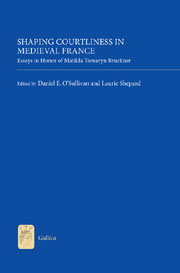Book contents
- Frontmatter
- Contents
- List of Illustrations
- Acknowledgements
- Introduction
- Matilda Tomaryn Bruckner: A Bibliography
- Part I Shaping Real and Fictive Courts
- Part II Shaping Courtly Narrative
- Meraugis de Portlesguez and the Limits of Courtliness
- The Art of “Transmutation” in the Burgundian Prose Cligés (1454): Bringing the Siege of Windsor Castle to Life for the Court of Philip the Good
- Thomas's Raisun: Désir, Vouloir, Pouvoir
- Humanimals: The Future of Courtliness in the Conte du Papegau
- A Matter of Life or Death: Fecundity and Sterility in Marie de 139 France's Guigemar
- Le Roman de la Rose, Performed in Court
- Part III Shaping Women's Voices in Medieval France
- Part IV Shaping the Courtly Other
- Envoi
- List of Contributors
- Index
- Tabula Gratulatoria
- Already Published
The Art of “Transmutation” in the Burgundian Prose Cligés (1454): Bringing the Siege of Windsor Castle to Life for the Court of Philip the Good
from Part II - Shaping Courtly Narrative
Published online by Cambridge University Press: 05 May 2013
- Frontmatter
- Contents
- List of Illustrations
- Acknowledgements
- Introduction
- Matilda Tomaryn Bruckner: A Bibliography
- Part I Shaping Real and Fictive Courts
- Part II Shaping Courtly Narrative
- Meraugis de Portlesguez and the Limits of Courtliness
- The Art of “Transmutation” in the Burgundian Prose Cligés (1454): Bringing the Siege of Windsor Castle to Life for the Court of Philip the Good
- Thomas's Raisun: Désir, Vouloir, Pouvoir
- Humanimals: The Future of Courtliness in the Conte du Papegau
- A Matter of Life or Death: Fecundity and Sterility in Marie de 139 France's Guigemar
- Le Roman de la Rose, Performed in Court
- Part III Shaping Women's Voices in Medieval France
- Part IV Shaping the Courtly Other
- Envoi
- List of Contributors
- Index
- Tabula Gratulatoria
- Already Published
Summary
“Transmutation” is the term used by the anonymous authors of two midfifteenth- century Burgundian prose romances to designate the process by which they transform two of Chrétien de Troyes's romances, Erec et Enide and Cligés. The author of the prose Cligés, noting his contemporaries’ willingness to pass their time reading and listening to romances and histories, proposes to better serve them by transposing – the verb is transmuer – Alixandre's and Cligés's adventures from Old French verse to Middle French prose. But transmutation is not just translation. The prose redactors appropriate Chrétien's texts and modify them to such an extent as virtually to reinvent the original romances. These are not simply the verse romances stripped of Chrétien's inimitable irony and humor, as earlier critics had claimed. While the prose texts respect the general outline of the original plot, the transformations affect every aspect: language, style, and content. Many of the changes can be attributed to “acculturation,” a process of updating whereby, according to Jane H. M. Taylor, “the socio-culturally unfamiliar is recast in familiar terms, so that the reader can understand systems and phenomena in a source text as corresponding to his own ideologies, preconceptions and behaviour patterns.”
- Type
- Chapter
- Information
- Shaping Courtliness in Medieval FranceEssays in Honor of Matilda Tomaryn Bruckner, pp. 95 - 106Publisher: Boydell & BrewerPrint publication year: 2013



